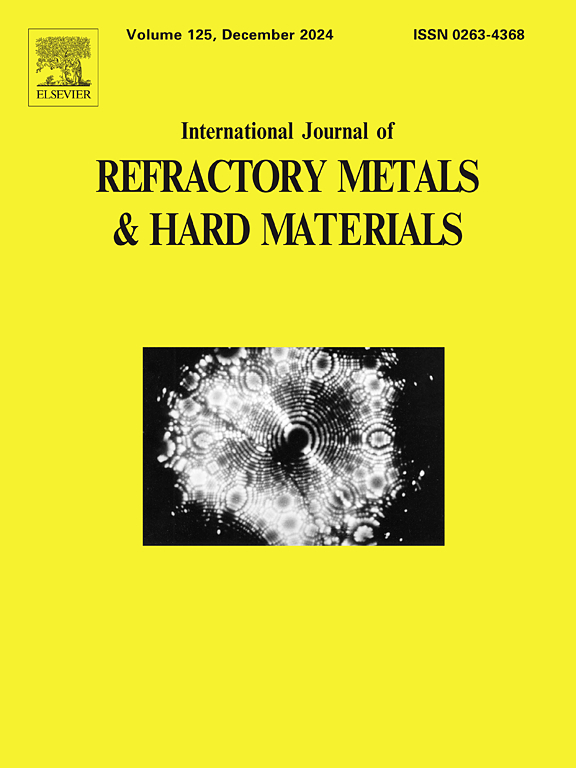Effect of different composition ratio on mechanical properties of W-Fe-B alloy
IF 4.2
2区 材料科学
Q2 MATERIALS SCIENCE, MULTIDISCIPLINARY
International Journal of Refractory Metals & Hard Materials
Pub Date : 2025-04-10
DOI:10.1016/j.ijrmhm.2025.107181
引用次数: 0
Abstract
W-Fe-B ternary system with different composition ratio were fabricated the pressureless sintering method. Effects of different original powder content on the mechanical properties of the alloy at different W/B ratios were systematically investigated. The results showed that the density varies with the proportion of elements and raw materials in the alloy. W2FeB2 hard particles size, hardness, compressive strength and bending strength of W-Fe-B alloy first increased and then decreased with W/B element ratio changing from 0.5 to 0.6 and W raw powder content increasing from 45 wt% to 50 wt%. Synthesized W-Fe-B alloys have superior comprehensive properties with hardness of 531.4 ± 0.3 HV, compressive strength of 1050 ± 2 MPa and bending strength of 955 ± 5 MPa under 0.57 W/B ratio and 47.5 wt%-W. According to the results of tests, high performance W-Fe-B alloy would make greater contributions in future cutter and mould industries.
不同成分配比对W-Fe-B合金力学性能的影响
采用无压烧结法制备了不同组成比的W-Fe-B三元体系。系统研究了不同原粉含量对不同W/B比合金力学性能的影响。结果表明,合金的密度随合金中元素和原料的比例而变化。W- fe -B合金的W2FeB2硬颗粒尺寸、硬度、抗压强度和抗弯强度随W/B元素比从0.5增大到0.6,W原粉含量从45 wt%增大到50 wt%而先增大后减小。合成的W- fe -B合金在0.57 W/B比和47.5% wt%-W下,硬度为531.4±0.3 HV,抗压强度为1050±2 MPa,抗弯强度为955±5 MPa,综合性能优越。试验结果表明,高性能的W-Fe-B合金将在未来的刀具模具工业中做出更大的贡献。
本文章由计算机程序翻译,如有差异,请以英文原文为准。
求助全文
约1分钟内获得全文
求助全文
来源期刊
CiteScore
7.00
自引率
13.90%
发文量
236
审稿时长
35 days
期刊介绍:
The International Journal of Refractory Metals and Hard Materials (IJRMHM) publishes original research articles concerned with all aspects of refractory metals and hard materials. Refractory metals are defined as metals with melting points higher than 1800 °C. These are tungsten, molybdenum, chromium, tantalum, niobium, hafnium, and rhenium, as well as many compounds and alloys based thereupon. Hard materials that are included in the scope of this journal are defined as materials with hardness values higher than 1000 kg/mm2, primarily intended for applications as manufacturing tools or wear resistant components in mechanical systems. Thus they encompass carbides, nitrides and borides of metals, and related compounds. A special focus of this journal is put on the family of hardmetals, which is also known as cemented tungsten carbide, and cermets which are based on titanium carbide and carbonitrides with or without a metal binder. Ceramics and superhard materials including diamond and cubic boron nitride may also be accepted provided the subject material is presented as hard materials as defined above.

 求助内容:
求助内容: 应助结果提醒方式:
应助结果提醒方式:


